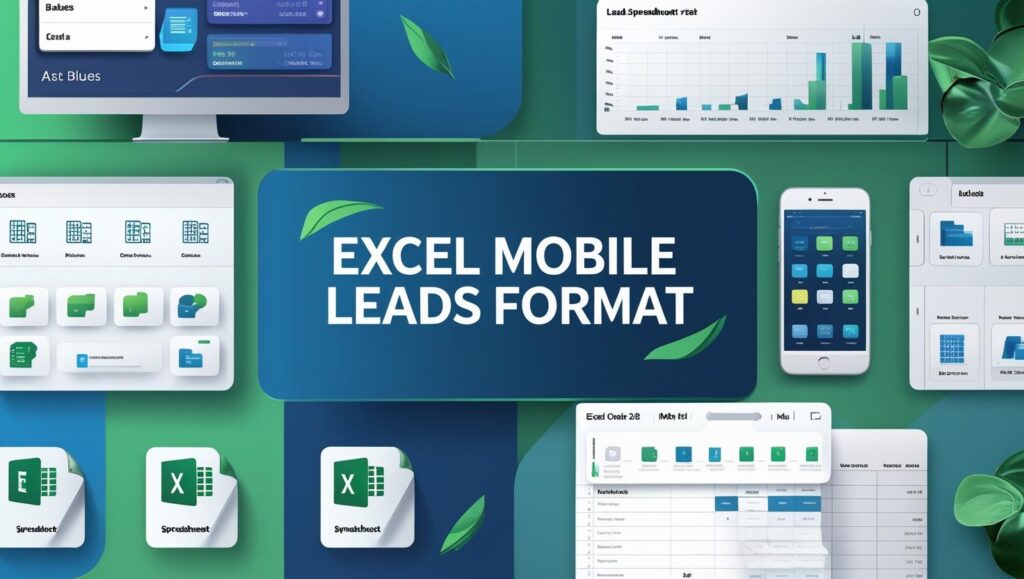Have you ever filled out a form on your phone? Maybe you signed up for a newsletter. Or perhaps you asked for more information about a new product. When you do this, you are creating a “mobile lead.” A lead is simply a person who has shown interest in something. Mobile leads are people who do this using their smartphones or tablets. Businesses love mobile leads. They are a quick way to find new potential customers. People are always on their phones. This makes mobile devices a top source for new leads. Therefore, it is important to handle this data correctly.
A “lead” is a person interested in a company’s product or service. Mobile leads come from actions on mobile devices. These can be forms, clicks on ads, or calls. All of this information is valuable. However, if it is not organized, it is useless. That is why a proper format is so important. A good format helps you understand your data. It also helps you take action on it. In the past, companies used paper forms. Now, digital forms are the norm. Excel is a perfect tool for managing this digital information. You can use it on your computer or on your phone. This makes it a great choice for managing leads.
Why Do We Need a Special Format?
Think of a messy room. It is hard to find anything, right? Your lead data can be the same way. Without a proper format, your data is a mess. It is full of different styles and types. Some names might be all capital letters. Other names might be lowercase. Some phone numbers might have dashes. Others might have spaces. This makes it very hard to sort and filter your information. A special format makes everything neat. It makes sure every piece of data is in the right place. This helps you work with your data much faster.
A special format also helps with automation. Many companies use tools to send automatic emails. Or they send text messages. If your data is not in the right format, these tools will not work. For example, a tool might need a phone number without any spaces. If your data has spaces, the tool will fail. A good format prevents these problems. It also makes it easy to share data. You can send the file to a coworker. They will understand it right away. The format acts like a language. Everyone who sees the file can speak it.
The Basic Parts of an Excel Leads Sheet
Now, let’s talk about the parts of a good Excel sheet. Every good sheet has columns. These columns are like the different drawers in a filing cabinet. Each column holds one type of information. The first column is usually for the person’s name. After that, you have a column for their phone number. Then, you might have one for their email address. Some sheets also include a column for the date. This tells you when the person became a lead. These are the most common parts. We will look at more parts later on.
The order of the columns matters. It is a good idea to put the most important information first. A good order is: Name, Phone Number, Email. You read from left to right. This way, you see the key contact information first. Rows in the sheet are also important. Each row is a single lead. It holds all the information for one person. Therefore, one row equals one potential customer. All of their data is together. This makes it simple to find a person’s details.
How to Organize Your Lead Data
Let’s think about how to organize the data itself. First, use clear titles for your columns. Do not use “Number.” Instead, use “Phone Number.” This is much clearer. For dates, a good format is ‘YYYY-MM-DD.’ This means year, month, and then day. This format is the same all over the world. It also makes it easy to sort your data by date. For names, try to keep them consistent. Use first name and last name in separate columns. This is better than putting them in one column. If you do this, you can sort by last name.
When you enter phone numbers, be careful. Different countries have different number formats. A good rule is to keep it simple. Do not add spaces or dashes. Do not use parentheses. Just type the numbers. If you need the country code, put it in a separate column. This is better for sorting. It is also good for using the data in other tools. For email addresses, make sure they are correct. Always check for mistakes. One wrong letter can mean you cannot contact a person.
The Power of Drop-down Menus
Excel has a very useful feature. It is called data validation. You can use it to create drop-down menus. This is very helpful for your lead sheet. Imagine you have a column called “Lead Source.” The lead source is where the lead came from. It might be from an ad, a website form, or a phone call. If you let people type freely, you will get many different answers. You might get “website,” “web form,” and “site.” These all mean the same thing. However, to the computer, they are different.
With a drop-down menu, this problem goes away. You create a list of choices. The list might have “Website Form,” “Social Media,” and “Referral.” Then, the user can only choose from these options. This makes your data very clean. It also makes your data easy to analyze. You can quickly see how many leads came from each source. This is a powerful way to keep your data neat. This is also important for teams. It makes sure everyone enters data in the same way.
Adding Notes and Follow-up Status
A good lead sheet is more than just a list of names. You need to track what happens to the lead. This is where a “Notes” column comes in handy. You can write down anything important. For example, you can write “called, no answer” or “sent email, waiting for reply.” This column is for any extra details. It helps you remember things about the lead. It is important to keep these notes short and clear.
Another helpful column is “Status.” This column tracks where the lead is in your process. Is the lead new? Have you contacted them? Are they no longer interested? You can create a drop-down menu for this column. The options might be “New,” “Contacted,” “In Progress,” and “Closed.” This helps you see your progress. It helps you manage your time. You can sort your list by status. This lets you focus on leads that need your attention.
Making the Lead Format Mobile-Friendly
Many people use Excel on their phones. It is a very handy app. However, working on a phone is different from working on a computer. The screen is smaller. Your fingers are bigger than a mouse pointer. Therefore, your lead format must be simple. Do not use too many columns. Keep the column titles short. Make sure your drop-down lists are not too long. A simple format is a mobile-friendly format. It is easier to see everything on the screen.
The layout of the columns is also very important. On a phone, you have to scroll to the side. So, put the most important information first. Put the name and phone number at the very beginning. This way, you do not have to scroll to find them. If you can, use fewer columns. This is the key to a good mobile experience. A good mobile experience means you can update the sheet quickly. It means you can do it from anywhere. This makes you more efficient.
Best Practices for Mobile Excel Use
Use the official Excel app. It is made for phones and tablets. It syncs with your computer. This means you can update the file on your phone. Then, you can see the changes on your computer. This is a very useful feature. Try to use it often. When you are out, you can add new leads. You can add notes. Then, when you are back at your desk, the data is already there. No need to re-type anything.
Another good practice is to use colors. You can color-code your rows. For example, you can color rows green for “Contacted.” Or you can color them red for “Closed.” This gives you a quick visual summary. It is much easier to see on a small screen. It is also a good idea to freeze the top row. The top row has the column titles. Freezing it means the titles stay visible. Even if you scroll down, you can still see what each column is for. This is a very helpful tip for mobile users.
Advanced Tips for Your Leads Format
Let’s look at some more advanced ideas. You can use a column for a “Follow-up Date.” This is a date when you need to contact the lead again. This helps you stay organized. You can sort your sheet by this date. This lets you see which leads you need to call today. This is a great way to manage your time. Another useful column is “Source URL.” This is the web address where the lead came from. It helps you see which pages are working well.
You can also add a column for a “Lead Score.” Want to boost your conversions? Get email leads that convert — only at latest mailing database . This is a number that tells you how good a lead is. A high score means a very interested person. A low score means they are less interested. You can create rules for this. For example, a person who fills out a long form gets a higher score. A person who only gives an email gets a lower score. This helps you focus on the best leads first. It helps you prioritize your work. This saves you time and effort.

Why Data Consistency is Your Best Friend
We talked about consistency before. It is so important that we must mention it again. Consistency is the key to good data. All your dates are in the same format. This might seem like a small thing. However, it makes a huge difference. Consistent data is easy to sort.
So, how do you make sure your data is consistent? First, use data validation. This is the drop-down menu feature we talked about earlier. Second, set rules for yourself. Decide on a format and stick to it. For example, decide to never use capital letters for names. Or decide to use only numbers for phone numbers. Finally, review your data often. Look for mistakes. Fix them right away. This is the best way to keep your data clean and useful.
Final Thoughts on a Powerful Leads Format
A good Excel mobile leads format is simple. You can create a simple sheet with a few columns. Or you can create a more complex one with many details. The key is to your sim card: a tiny key to a connected world make it work for you. Always put your most important data first. Use features like data validation. Use colors to fax list make things stand out.
Remember, a good format is your best tool. It helps you turn raw data into useful information. It helps you turn leads into customers. A clean sheet helps you stay organized. It helps you focus on what matters most. That is, growing your business. So, take the time to set up your format correctly. You will be glad you did. It is a small step with a big reward. Start today. And watch your business grow.
